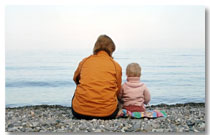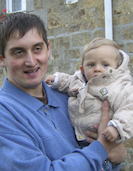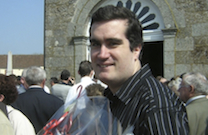Fragile-X syndrome: Insight from two generations
 Elisabeth* took two years’ leave when her second child was born in 1998, because she wanted to spend time with him. “Spending every day with Paul*, I could see that he was different. He shied away from company, and it was clearly painful for him when I began leaving him in daycare for an hour or two. Separation was proving much more difficult and dramatic for him than for other kids,” recalls Elisabeth.
Elisabeth* took two years’ leave when her second child was born in 1998, because she wanted to spend time with him. “Spending every day with Paul*, I could see that he was different. He shied away from company, and it was clearly painful for him when I began leaving him in daycare for an hour or two. Separation was proving much more difficult and dramatic for him than for other kids,” recalls Elisabeth.
Elisabeth tried to alert her family and her doctor but she would get the typical “don’t worry about it” answers or the “maybe it’s to do with the way you are raising the child” retorts. When Paul entered preschool, the paediatrician finally decided to do some tests and a karyotype. “I remember thinking that the results would reassure me once and for all because I assumed they would be negative.” Unfortunately, there was no such reassurance: Paul was diagnosed with Fragile X syndrome when he was 2 ½ years old. “I felt that my world had been turned upside down.”
 It took over ten years to obtain a correct diagnosis for Antoine and Sebastien. Both children were born to Viviane, a nurse, after difficult pregnancies – in 1979 and 1981. Sebastien was hypotonic and only started walking at five years old, he was misdiagnosed with autism and hydrocephalus; Antoine displayed normal development, began walking at nine months but was hyperactive. “I had one child who would hide behind the door, playing endlessly with a small plate and another who would run everywhere and bang his head on the walls,” says Viviane. When they started preschool, the teaching team sat with Viviane and asked her “what was wrong at home for the two boys to be like this”.
It took over ten years to obtain a correct diagnosis for Antoine and Sebastien. Both children were born to Viviane, a nurse, after difficult pregnancies – in 1979 and 1981. Sebastien was hypotonic and only started walking at five years old, he was misdiagnosed with autism and hydrocephalus; Antoine displayed normal development, began walking at nine months but was hyperactive. “I had one child who would hide behind the door, playing endlessly with a small plate and another who would run everywhere and bang his head on the walls,” says Viviane. When they started preschool, the teaching team sat with Viviane and asked her “what was wrong at home for the two boys to be like this”.
 “We were isolated. I had therapy for five years, my husband had therapy, and even our boys were seeing the psychiatrist. A section of our family rejected us.” After watching the Telethon in 1987 and hearing stories that resembled her daily life, Viviane decided to contact a geneticist. “Sebastien and I were hospitalised for eight days and we had numerous, painful tests done”. Three months later, a routine letter informed Viviane that Sebastien had Fragile-X, that the disease was hereditary, genetic and that she should get the family tested. “I howled because I understood that I had passed it on to my sons. There was no-one to tell us what to do, where to begin, and back in 1989, there was nothing on Fragile-X.” Viviane and her sons were the first people to be diagnosed in the French region of Basse-Normandie and agreed to be case studies. A year later, Viviane and her husband Xavier created the first X-Fragile patient association in France (and Europe), Le Goëland.
“We were isolated. I had therapy for five years, my husband had therapy, and even our boys were seeing the psychiatrist. A section of our family rejected us.” After watching the Telethon in 1987 and hearing stories that resembled her daily life, Viviane decided to contact a geneticist. “Sebastien and I were hospitalised for eight days and we had numerous, painful tests done”. Three months later, a routine letter informed Viviane that Sebastien had Fragile-X, that the disease was hereditary, genetic and that she should get the family tested. “I howled because I understood that I had passed it on to my sons. There was no-one to tell us what to do, where to begin, and back in 1989, there was nothing on Fragile-X.” Viviane and her sons were the first people to be diagnosed in the French region of Basse-Normandie and agreed to be case studies. A year later, Viviane and her husband Xavier created the first X-Fragile patient association in France (and Europe), Le Goëland.
A decade later, when Elisabeth was learning of her son’s disease, many things had changed. The FMR1 gene responsible for the syndrome was discovered in 1991 and Le Goëland patients’ organisation – doing a lot to raise awareness – existed, but still, Elisabeth was not offered much support when her diagnosis was announced. “The paediatrician did not say much and I did not grasp the reality of it. My son has a mosaic form of Fragile-X and physically he was doing OK. I was not prepared for what was coming.” A geneticist gave Le Goëland’s details to Elisabeth and she quickly met with other parents and became involved. “We want the same thing: comfort from other parents, to hear of daily lives that resemble ours, help in facing our fears, our guilt” says Elisabeth.
Viviane credits the “incredible” team that surrounded her and her family. “My colleagues, the geneticists, doctors and therapists allowed our family to be strong, to stay together and face this syndrome, which I look upon as a stranger barging into your life and forcing you to abide by his laws.” Elisabeth, unfortunately, did not have this support. Her husband left her soon after the diagnosis and she had to deal with everything on her own. For three years, she tried to work it out. “Paul was an outpatient and attended school two mornings per week. Other parents were complaining about him unsettling the other children, no allowances were made for him at school, and at the hospital he was just being kept busy,” remembers Elisabeth. The mother of two decided to move and found a wonderful school in Châtelaillon where they have an integrated school class for children with special needs (CLIS). Paul was taken care of, was involved in many activities, made friends and he loved every minute of it. But last year, he started secondary school. “He was lost; he was only at the school for two hours before being sent by cab to another place where he does nothing. He had two crises; the school sent him to psychiatric hospital where he was drugged and where he stayed a few days. Then, they expelled him for two days!” recalls Elisabeth.
After years in the wilderness without diagnosis, Viviane spent years in the wilderness without care. Integrated school classes did not exist and any child repeating a school year was immediately referred to the Medical and Educational institute (IME). At the IMEs, diagnosis was actually taboo! “Twenty years ago, you were told that having a handicapped child was suffering enough, so why add a disease name on top? So my boys were in IME, treated like all the others and we paid for private therapists.” Viviane and Xavier continued to work full time to be able to give their sons the correct care. Viviane would do night shifts and Xavier would work in the day. It took daily patience, drawings, military organisation, discipline, faith and four years for Sebastien and Antoine to grasp the meaning of time. “My energy is proportional to the shock of being a mother who has passed the syndrome onto her children,” says Viviane, who is now acting president of Alliance Maladies Rares. Antoine and Sebastien both work in Special Work Centres (CAT) where the former hyperactive child engages his passion for precision welding!
Paul has changed school again and is now in a boarding school, four hours’ drive from home. “It’s hard to be separated. I can’t keep him at home because it would be too expensive, I can’t move because I have my job here, so I have no choice,” Elisabeth says sadly.
*Names have been changed
This article was first published in the June 2011 issue of the EURORDIS newsletter
Author: Nathacha Appanah
Photo credits: © EURORDIS & V.Viollet
